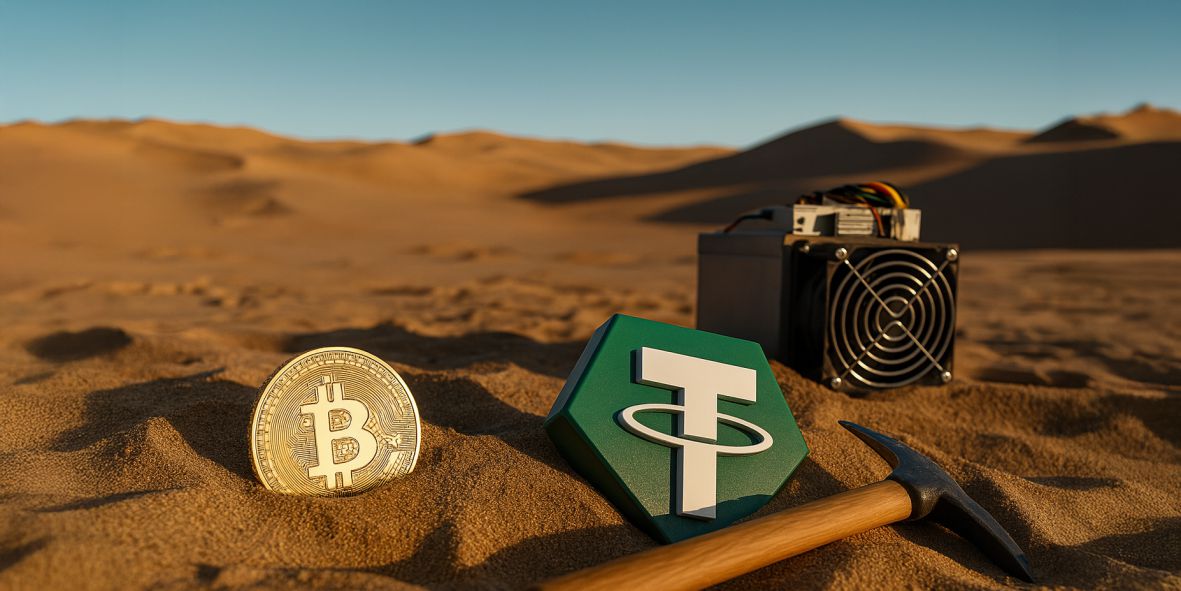Key Takeaways:
- Tether plans to become the world’s largest Bitcoin miner by the end of 2025, positioning itself as both a market player and network guardian.
- Tether views mining not as a path to profit, but as a way to protect its large Bitcoin holdings and support the network’s long-term security.
- CleanSpark, BitFuFu, and Riot Platforms posted strong June numbers, highlighting the operational scale Tether will need to compete with.
- A solo miner hit a $350K block with just 2.3 PH/s, showing there’s still room for new players, regardless of size.
Tether, the company behind the world’s largest stablecoin (USDT), plans to become the world’s largest Bitcoin miner by the end of 2025, according to Chief Executive Paolo Ardoino, who’s aiming to secure the blockchain that underpins its core holdings by joining the mining race.
Speaking on a recent episode of the Bankless podcast, Ardoino confirmed the company’s ambitions, stating that Tether intends to become the top miner globally by year’s end.
We are set to become, probably, the biggest miner in the world at the end of this year.
During his speech, Ardoino acknowledged that direct Bitcoin investment typically outperforms mining from a profitability standpoint.
If you have an X amount of money to invest… 99% of the time you will make more profits if you invest directly in Bitcoin rather than doing Bitcoin mining
However, Ardoino emphasized that Tether’s motive is not financial gain but long-term network security. With over 100,000 BTC on its books, Tether sees mining as a way to reinforce the integrity of the protocol.
If you have hundreds of thousands of Bitcoin, you want to participate in the security of the network…You are protecting your treasury.
Ardoino argued that Tether’s dual role as a major holder and miner would make it “the most aligned actor” in the Bitcoin ecosystem. He noted that the company is focused on decentralizing mining infrastructure to reduce concentration risks.
To that end, Tether has launched mining operations across several regions. “We have operations in South America, in many different countries, and of course also in the U.S.,” Ardoino said. “We are investing in U.S. Bitcoin mining. We really believe in the importance of the U.S., especially at this particular moment in time.”
Ardoino also addressed longer-term concerns about Bitcoin’s sustainability as block subsidies diminish. He predicted that transaction fees on the main chain would rise significantly, transforming how the protocol is used.
“When the block reward goes towards zero… fees on-chain will skyrocket,” he said, suggesting that Bitcoin’s base layer will serve primarily as a settlement network for large-scale or high-value activity via second-layer solutions like the Lightning Network.
He called this emerging structure “one of the most beautiful dynamics” in Bitcoin’s long-term development. “Bitcoin will become a security layer for anchoring everything else,” he added. “It will not be used for daily transactions.”
What Tether Is Going Up Against
As Tether positions itself for dominance in Bitcoin mining, it enters a competitive field already led by well-established players operating at an industrial scale.
CleanSpark, BitFuFu, and Riot Platforms are among the sector’s most prominent firms, each reporting strong output and infrastructure growth in June, highlighting the scale of the challenge Tether faces, even with deep financial resources.
CleanSpark mined 685 BTC last month, a 50% increase from the same period a year earlier. The company scaled its operational hashrate to 50 EH/s, up 145% year-over-year, and now holds over 12,600 BTC. “The tireless efforts of our operations and technology teams resulted in the addition of over 10 EH/s of capacity across four states,” said Chief Executive Zach Bradford, commenting on the new operations.
BitFuFu, supported by mining equipment manufacturer Bitmain, recorded its strongest month of 2025 with 445 BTC mined in June. The company reported a total managed hashrate of 36.2 EH/s and 728 MW of power capacity across five continents. It also surpassed 623,000 registered cloud mining users.
Riot Platforms mined 450 BTC in June but chose to scale back operations in Texas during periods of high electricity demand. The move was part of its participation in the state’s Four Coincident Peak (4CP) program, which offers financial incentives to companies that reduce power use when the grid is under strain. “Our power strategy significantly contributes to grid stability while enhancing Riot’s competitive positioning,” said CEO Jason Les.
Tether will need to match not only the scale of these firms but also their operational agility and energy strategies if it hopes to compete at the top of the mining industry.
Bitcoin Still Has Room for the Lucky Few
Away from the competition between industrial miners and corporate giants, a reminder surfaced in July that operational scale isn’t everything in Bitcoin mining.
A solo miner, operating with just 2.3 petahash per second, which is considered a fraction of what large mining farms deploy every second, managed to solve a block and claim the full reward, worth approximately $350,000.
The odds of such a win were extraordinarily low, making it one of the rarest outcomes in today’s mining environment.
The solo miner’s win may not alter the balance of power, but it offers a clear reminder that Bitcoin’s protocol remains probabilistic and open, allowing anyone, regardless of size, to take part in securing the network. This achievement also highlights that success in Bitcoin mining isn’t reserved for the biggest players.
To sum up:
Tether’s move into Bitcoin mining marks a strategic shift from holding digital assets to directly participating in the infrastructure that secures them, with the company aiming to become the world’s largest miner by the end of 2025, citing long-term network security as its primary motivation.
The company is entering a field already dominated by established firms. CleanSpark, BitFuFu, and Riot Platforms have scaled operations across multiple continents and optimized energy strategies, raising the competitive threshold for new entrants.
Despite increasing industrialization, the network continues to demonstrate its accessibility.
In July, a solo miner with just 2.3 petahash per second secured a full block reward worth over $350,000. The event, being extremely rare, illustrates that Bitcoin mining remains probabilistic and open to participants regardless of scale.
In an industry dominated by terawatts of power and exahash-scale operations, there is still room for luck, and for those quietly mining on the margins.
Read More: Ethereum’s Buterin Supports ‘Copyleft’ Licensing for Crypto







